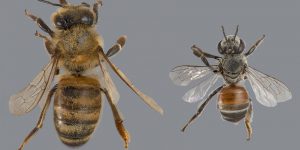Beekeepers to monitor hives for Red Dwarf honey bee in Australia
The Department of Primary Industries and Regional Development is responding to a detection of Red Dwarf honey bee in the Perth suburb of Forrestfield, calling on the State’s beekeepers to check their hives for the pest.
Comparing Size between European Honey Bee and Red Dwarf Honey Bee
The Department of Primary Industries and Regional Development is responding to a detection of Red Dwarf honey bee in the Perth suburb of Forrestfield, calling on the State’s beekeepers to check their hives for the pest.
A single swarm of the exotic bees was found on a recently imported sea container transferred to Forrestfield. The swarm was quickly contained and destroyed.
Beekeepers with hives along the rail transport route between Fremantle and Forrestfield have been asked to inspect hives regularly and report anything unusual to the department’s Pest and Disease Information Service (PaDIS).
Chief Plant Biosecurity Officer Sonya Broughton said Red dwarf honey bee was native to Asia, and was a vector of bee diseases, parasites and viruses.
Dr Broughton said a single Euvarroa mite was confirmed on one of the detected bees, but this should not cause alarm. The mite reproduces on the drone brood of Red Dwarf honey bees and is not known to naturally parasitize our European honey bee.
The Red Dwarf honey bee is a risk to European honey bee and native bees as it competes for floral resources.
“This detection was very quickly contained, and we continue to conduct extra surveillance to protect our bee and horticulture industry,” Dr Broughton said.
“DPIRD surveillance activities have not detected any further exotic bees other than the original single exotic bee swarm.”
Red Dwarf honey bees are social bees that live in colonies of approximately 3,000 insects and swarm readily.
Dr Broughton said the bee was distinguished by its small size in comparison to European honey bees.
“This exotic bee is just 7-10 millimeters in length and constructs small hives, usually less than 25 centimeters wide, consisting of a single comb,” she said.
“The Red Dwarf honey bee has a red/brown abdomen with black and white bands.
“It is important exotic bee and bee pests are reported quickly to provide the best opportunity to protect Western Australia’s valuable bee and horticultural industries.”
Unusual bee or hive observations should be reported immediately to PaDIS using the department’s MyPestGuide Reporter app, telephoning (08) 9368 3080 or email padis@dpird.wa.gov.au.
Beekeepers to monitor hives for Red dwarf honey bee (www.wa.gov.au)









